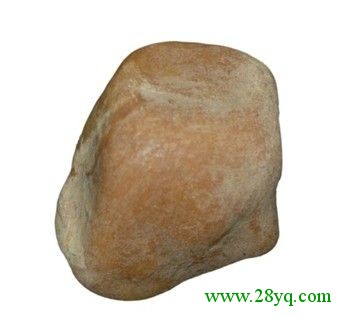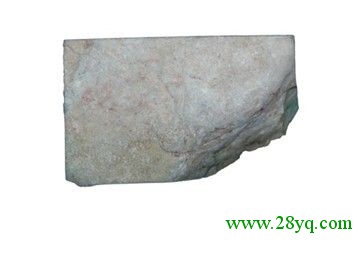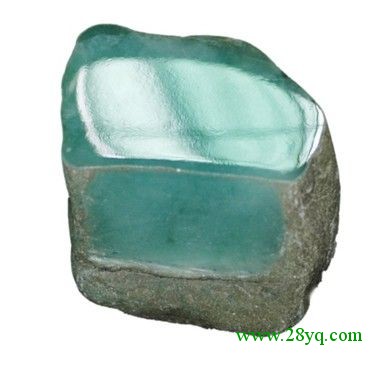The jadeite collection entry Wikipedia original stone
 The skin color forming the emerald skin refers to the color of the jade weathered skin. The weathering of the original stone of Jadeite changes, and gradually the color of the epidermis is most strongly affected by weathering. The process from the inside to the inside gradually fades. When it reaches the interior of jadeite, no jadeite skin is visible. On the color. This part of the transition from watch to watch is called “skin, fog, and flesh†in the industry. The characteristics of skin fog meat is also an important basis for experts to judge Jade bet stone (for details, see Part V).
The skin color forming the emerald skin refers to the color of the jade weathered skin. The weathering of the original stone of Jadeite changes, and gradually the color of the epidermis is most strongly affected by weathering. The process from the inside to the inside gradually fades. When it reaches the interior of jadeite, no jadeite skin is visible. On the color. This part of the transition from watch to watch is called “skin, fog, and flesh†in the industry. The characteristics of skin fog meat is also an important basis for experts to judge Jade bet stone (for details, see Part V). 
Jade skin The vast majority of jadeite stones have a weathered crust, which is the product of the weathering effect of jade stone in the geological handling process. It is called “the huskâ€. The skin color is black, gray, yellow, brown, light yellow, white and other colors, according to the color, density, degree of smoothness, convexity and concavity of the skin can roughly estimate the color of the interior of the jadeite material, the head is good or bad, Kind of old tender and cracked. For example, if the skin is dense and smooth, it usually shows good internal transparency and less impurities. The surface of the skin is not obvious as a moss, and often shows that it may have green inside; the surface of the skin is rough and uneven, indicating that there are many cracks in it, texture Loose, poor water; if there is a large change in the color of the jadeite skin, and there are bandages such as black louse, it should pay attention to the possibility of green.
If the husk is rough, there is a sense of sandstone jadeite, known as sandstone. According to the color of the sand skin can be divided into: white sand skin, yellow sand skin, iron sand skin, black black sand skin and so on. White sand skin jadeite often has no color inside, if there is a faint green or purple, but generally better transparency; yellow sand skin inside the jadeite stone may have more green, but most of the color is not uniform, and sometimes may have more concentrated Color root; yellow and white sand skin after the water has the feeling of fine sand loss, general water head and foot. Brown skin is also known as yellow peony skin, and the species is usually very old. If the skin is delicate and the moss-like and black strips cover the water, there may be high-courage; generally, the skin of the iron sand skin is thin, and the internal quality is good. Out of high-grade materials; black ebony black and green with darker colors, and deeper green parts inside are more likely to occur, and even full green jade can appear, but the black ebony jadeite rough stone changes very much, with iron There are many impurities, some of which have dark spots in the green, some are green and dry, and some are green and dirty; the lime skin is gray and the skin is soft, and the lime peel can be brushed off with an iron brush. The internal texture is generally good. In addition, there is the erosion of the water, the skin is smooth, the hand feels no sand, very delicate stone skin. This kind of skin is very thin, and there are many kinds of colors, such as brown, cyan, light yellow and so on. Due to the thin skin of the water-peeled stone, the light can pass through the rough surface of the rough stone and it is easier to judge the situation inside. Aquatic stones are generally transported over a relatively long distance, and the denser and more delicate parts are retained, so the general quality is better.
In short, based on the color, density, degree of lightness, and thickness of the Jadeite crust, the degree, transparency, cleanliness, structure, etc. of the Jadeite are estimated and the overall situation is estimated.

Emerald fog “mist†refers to a layer of fog-like opaque matter that exists between the outer weathered crust and the inner emerald. It is actually a result of a jadeite mineral retrograde metamorphism. Due to the decrease of temperature and increase of pressure, the original mineral jadeite is degenerated and a new secondary mineral is enclosed outside the jadeite rock. The center part is the jadeite rock, the outside is the secondary mineral layer, and the outermost layer is the pattern of the weathering crust. . In short, "fog" refers to a half-oxidized jadeite layer between the skin of emerald (weathered or oxidized) and the interior of jadeite (without weathering or oxidation) or meat. In essence it is also a part of jadeite, a transitional zone from weathered crust to unweathered flesh (emerald). These secondary minerals are mainly albite and nepheline. The “fog†is thick and thin, with white fog, yellow fog, dark fog, and red fog. The presence of fog and the color of the fog reflect the original rock information.

The appearance of "fog" is a sign that there is a green color, different colors of fog have different indications, can indicate the number of impurities inside jadeite, "species" are always new, transparency is good or bad and its internal cleanliness, etc. However, it cannot explain whether there is green within it and has nothing to do with green. If the skin is polished away, the pale white is called white fog, indicating that the impurities are small and the ground is clean. The iron content is not high. It is a relatively pure jadeite rock with a certain degree of transparency. If there is white fog, Green, it may be a very pure green, matching with the bottom is worth the price. White fog also shows that "species" are old, and most people like to gamble on white fog. In general, red fog and yellow fog are caused by high iron content, while high-speed iron makes jade green green. Yellow fog shows the presence of iron oxide but is not yet highly oxidized. If it is pure yellowish fog, it shows that there are few impurity elements and often appears high jade, but sometimes the blue-green color produced by iron ions may enter the interior of jadeite, and there is also a slight greenish blue-green tone. The red fog shows that the iron enrichment and high oxidation of the iron may cause the gray interior of the jadeite. Black fog is mainly caused by the appearance of a large number of internal impurities, and the transparency is poor. Some individual dark fogs also appear in high jade, but sometimes the water is poor. Not all jadeite produces fog. The "mist" of the jadeite produced by the primary deposit is almost non-existent. It is mainly due to the emerald fog of secondary deposits with strong weathering.
Emerald Meat The "meat" of emerald is found beneath the skin and fog. It is a real emerald. "Flesh" is a jadeite stone that is hardly affected by any external weathering. Since "meat" must exist inside the original stone of jadeite, the name "meat" is naturally formed relative to the name of the skin and fog. The industry is talking about meat. Refers to the rough degree of jadeite texture. If the component mineral particles are coarse, it is called "meat coarse", and then it is often rusted; on the contrary, if the component mineral particles are fine, it is called "meat fine". Even if the transparency is not high, this kind of jadeite will give people With a noticeably moist feeling. Suddenly, the coarse meat has become an important criterion for evaluating the quality of jadeite.

Jade pine flower jade vaguely visible some of the dry moss like color blocks, plaques, strips called "song flowers." "Songhua" refers to the green appearance of the jadeite shell, which is a representation of the interior of the jadeite or shallow green on the surface of the hull. It refers to the green color of the original jadeite material, and the traces left by weathering have faded. Since the species, concentration, and spatial distribution of the chromophores are relatively stable at certain metallogenic times and spaces, the internal color of the emerald can be inferred from variations in the density of the pine flower, the number, the degree of density, and the morphology of the distribution. Area size, shape, change and distribution. If the color of the pine flower is thick and bright, the value will be high; if there is no pine flower on the shell, there may be little coloration inside; and if there are multiple flowers on the skin, the interior may exist in color or exist only in the surface layer. In addition, whether the pine flower penetrates into the interior of the jadeite, the depth of penetration, etc. is also one of the basis for inferring the color. Observe that the water is carefully studied on the raw materials.
Rattan Storage Basket,Handmade Wooden Basket,Brown Wooden Basket,Rattan Handle Basket
J AND F COMPANY LTD. , https://www.jnfgardening.com